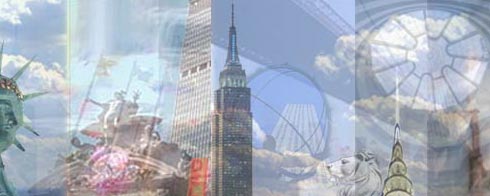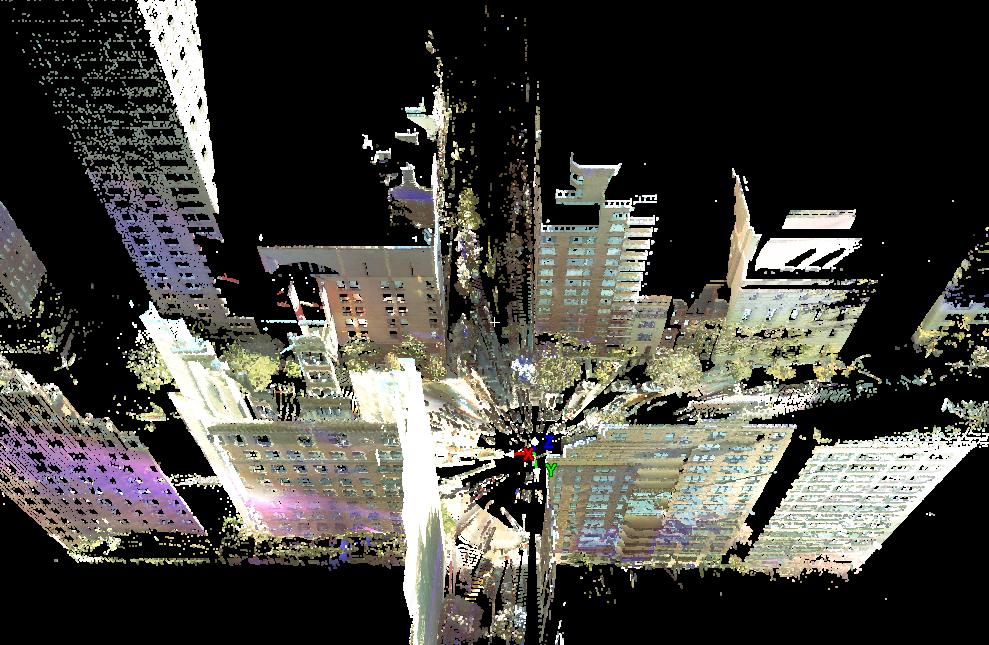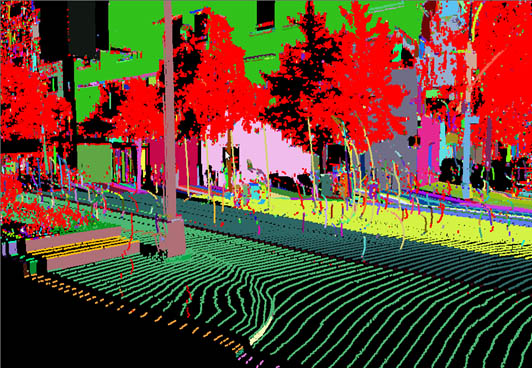
Figure: (a) 3D range scan of
Park
Avenue and 70th street (scanner is a the center of the
intersection).
Bird's-eye view. Data gathered by the Leica ScanStation2 of
our
laboratory. (b) 3D texture-mapped model of building at CCNY.
Camera
positions are shown (see IJCV 2008 paper in
publications).
(c) Online classification of objects in urban scene (red is
vegetation)
Course Overview
Recent advances in computer hardware have made possible the
efficient
rendering of realistic 3D models in inexpensive PCs,
something
that was possible with high end visualization workstations only a
few
years ago. This class will cover the field of 3D Photography -the
process of automatically creating 3D texture mapped models of
objects-
in detail. We will
concentrate
on the topics at the intersection of Computer Vision and Computer
Graphics that are relevant to acquiring, creating, and
representing 3D models of small objects or large urban areas. Many
very
interesting research questions need to be answered. For example:
how do
we acquire real shapes? how do we represent geometry? can we
detect
similarities between shapes? can we detect symmetries within
shapes? how
do we register 3D geometry with color images?, etc. Applications
that benefit by
this technology include: historical preservation, urban
planning,google-type maps,
architecture,
navigation, virtual reality, e-commerce, digital cinematography,
computer games,
just to name
a few.
The core of the
class will be a set of presentations of recent papers. The
research
facilities of the Vision
and Graphics Laboratory will become
available to registered class participants. The research of our
laboratory is supported by the National Science
Foundation through three active NSF awards. So, if you are
interested
for a research topic, please join the class!
Course
Format
There will be a weekly class, with presentations by the
instructor. The
presentations will introduce the basic concepts and techniques of
the
field. Each
student will
present one or two assigned topics in class. Outstanding projects
can
lead to succesful PhD theses, and to research paper submissions.
The grade will
be
based upon the following:
40% for group or individual projects, 40% for presentation(s)
and 20% for class participation.
Prerequisites
Students need to be
familiar with at least one of the following topics: Image/Pixel
Processing, Computer Vision, Computer Graphics, or Robotics. A
prerequisite can be waived by permission of the instructor. Please contact
Prof.
Stamos directly if you feel you do not have the required
qualifications. PhD, MS,
or
undergraduate students are eligible to register. Undergraduate
students
should contact Prof. Stamos before registering.
Topics
- Acquiring images: 2D and 3D sensors (digital cameras and laser
range scanners).
- 3D- and 2D- image registration.
- Geometry: representation of 3D models, simplification of 3D
models, detection of symmetry.
- Rendering 3D models.
- Image based rendering.
- Texture mapping.
Course Material

This class will be
based on recent publications and recent workshops. A set of
seminars,
books, and journals are provided for your reference.
Computer
Vision Books:
Computer Vision: Algorithms and Applications, Richard
Szeliski, 2010: Online Version
Introductory
Techniques for 3-D Computer Vision. EmanueleTrucco and
Alessandro
Verri. Prentice Hall, 1998.
Robot Vision. B. K. P. Horn, The MIT Press, 1998 (12th
printing).
Three-Dimensional Computer Vision: A Geometric Viewpoint.
Olivier Faugeras, The MIT Press, 1996.
An Invitation to 3-D Vision. Yi Ma, Stefano Soatto, Jana
Kosecka, S. Shankar Sastry. Springer-Verlag, 2004.
Computer Vision A Modern approach.
David
S. Forsyth, Jean Ponce. Prentice Hall 2003.
Computer Vision. Linda Shapiro and George Stockman. Prentice
Hall, 2001.
Computer
Graphics Books:
Computer
Graphics, Principles and Practice. Foley, van Dam,
Feiner, and Hudges. Addison-Wesley, 1997.
3D Computer Graphics. Alan Watt. Addison-Wesley,
2000.
OpenGL Programming Guide. Mason Woo, Jackie Neider,
Tom Davis.
Addison-Wesley, 1998.
Computer Vision
and Graphics Journals:
International
Journal on Computer Vision.
Computer Vision and Image Understanding.
IEEE Trans. on Pattern Analysis and Machine Intelligence.
SIGGRAPH
(http://www.siggraph.org).



